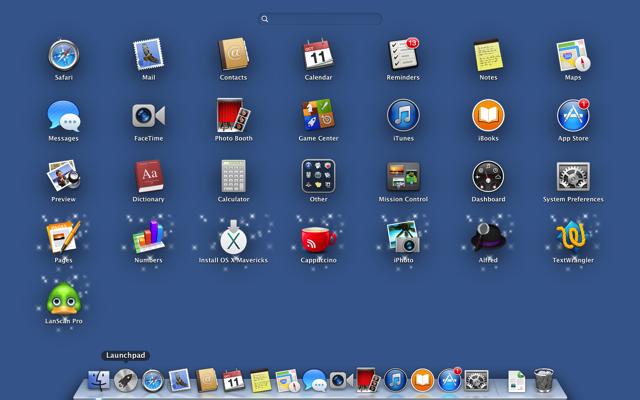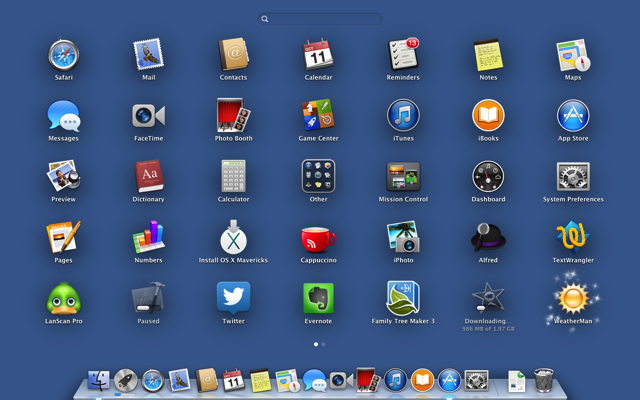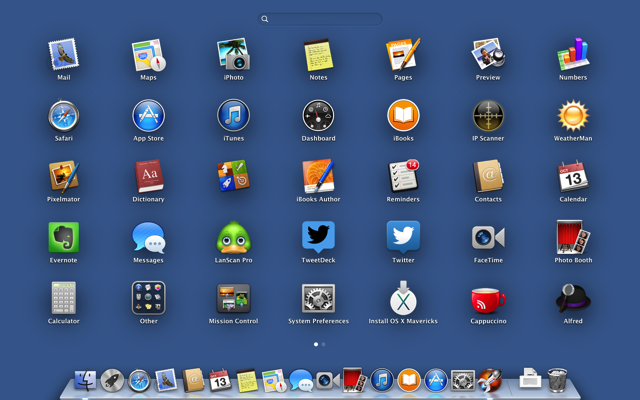Updated November 21st, 2015.
If you’re using Mac OS 10.7 or higher your Mac includes a very handy app called the Launchpad. Its icon (shown above) is probably in the Dock, and you’ve probably seen it, and maybe even used it– but without a little instruction you may not have realized its power. So here’s a little instruction.
What it does
The Launchpad gives you quick access to the applications on your Mac. It’s a lot like the Home screen on an iPhone or iPad– everything’s right there in front of you. Yes, there are other ways to get to your apps, but Launchpad is the easiest and nicest built-in way to see all of them.
Here’s a picture of the Launchpad doing its thing.

TRIVIA TIME: the “Home Screen” on the iPhone and iPad isn’t officially called the Home Screen. Officially, it’s known as “the Springboard.” I don’t know anyone who calls it that but “Springboard” is the official name. You can look it up.
If you click on an icon in the Launchpad– one click– that application launches. This makes launching apps very quick and easy. Of course you need to know how to launch Launchpad itself… that’s next.
How to launch the Launchpad
There are three easy, built-in ways to launch the Launchpad:
- Click the Launchpad icon in the Dock
- Activate Spotlight with Command-spacebar, then type “lau” or enough of “Launchpad” for Spotlight to suggest it, and then Return
- Use the keyboard shortcut assigned by default.
The keyboard shortcut assigned by default depends on your keyboard. Look for a function key (top row) with a picture that looks like this:

If your keyboard doesn’t have a picture like that try pressing F4 anyway. It might work. If it does, press it again and Launchpad will go away.
If Launchpad doesn’t respond when you press F4, or if you want to assign it to some other key, fix things up in System Preferences/Keyboard/Shortcuts. If you’re stuck, email me.
You’ll notice some sparklies in that first screenshot. The sparklies call your attention to apps that were recently added to the Mac. You have to see it for yourself– it’s a fun effect. Note that apps stop sparkling after you launch them, and eventually even if you don’t. So enjoy it while you can. You can also see in Launchpad, when downloading a new app, a little progress bar in the app’s icon. Next time you buy an app from the Mac App Store fire up the Launchpad and see.
If all the Launchpad did was show your Mac’s apps it would not be very impressive. And I would not be writing about it. But there are a lot of little niceties that make the Launchpad worth writing about. For example:
1. If you fill up the Launchpad’s screen with apps it will automatically create a second screen (and a third, and a fourth). You can switch screens with Command-right arrow/Command-left arrow, or by clicking the TINY white dots at the lower center of the screen, or by using a two-finger right- or left-swipe on a trackpad.
See below for a picture showing the TINY white dots. It also shows a couple of downloading apps– one paused (you pause the download by clicking on it).

2. If you type a letter or two Launchpad will narrow things down, showing only the apps it thinks you want. It’s sort of clever about it: if you type an “e” it doesn’t just show you apps that start with E. It also shows you apps where part of the name starts with E. Sort of neat. Note that you don’t have to click in the search box (at the top)– just start typing.

3. You can use the arrow keys to move around the screen until you’ve selected the app you want to launch. Then press Return or Enter on your keyboard to start that app right up.
4. You can delete an app right from the Launchpad by holding down the Option key and then clicking the little “x” that appears on each app’s icon, very similar to the way it works on the iPhone and iPad. I wouldn’t do this if I were you– you realize, don’t you, that you’re not just taking the app out of the Launchpad, right? You’re really deleting the app. Now that you know how it works you won’t be surprised at what happens. You do get a warning– “are you sure you want to delete this app”– but still, it’s a little risky. Don’t do it when you’re tired.
If you’re wondering why some apps don’t get the “x” it’s the same story as on the iPhone and iPad: you can’t throw away the things that Apple considers “standard.” And if you’re wondering why it takes a long time for something you delete using Launchpad to actually exit the Applications folder, well, so am I.
5. (How many sentences can I start with “Just as on the iPhone and iPad,…”? At least one more, I’m thinking.) Just as on the iPhone and iPad, you can drag icons around and arrange them as you please, even from one screen to another. Put all of your favorites on the first screen. Put all of your graphics apps in the bottom row. Put left-leaning rectangular icons in the top row, circles in the second row, more left-leaning rectangular icons in the third row, etc.

6. You can create little groups of apps by dragging one app on top of another. You can name the group, “just as on the iPhone and iPad.” There’s an “Other” group in the screenshot above. I don’t do this much because once an app’s in a group (technically, a “folder,” not that it looks anything like a folder), I tend to forget about it. Out of sight, out of mind! I mention it here because you are bound to accidentally create a group, and when you do you will want to know how to get back to “normal.” Simply click on the group, watch it expand, and then drag the icon(s) from the group onto any unused space.
Sounds great, yes? Well, that’s because it is great. There are two Launchpad caveats:
- It only shows apps that are in the Applications folder*.
- It doesn’t care at all how you might have arranged things in your Applications folder– for example, there’s no “Utilities” folder in the Launchpad though there is one in the Applications folder.
* Technically it shows apps that are in the Mac’s Applications folder AND in your own “User” Applications folder, but the latter is rarely used and it confuses people more to mention it than not. Now look what you made me do.
The hardest part about using the Launchpad is remembering to use it, especially for long-time Mac users who have already developed their own ways of bringing up apps. You ought to try it a couple of times yourself, if only to see how many apps, and which ones, are already installed on your Mac. I think, though, that once you’ve tried the Launchpad you’re going to like it– and use it– a lot.
Copyright 2008-2023 Christian Boyce. All rights reserved.Did this article help you?
Maybe you'd like to contribute to theChristian Boyce coffee fund.

Want some some quick iPhone how-tos?
Visit me at iPhoneinaminute.com.
Looking for quick tips about Macs?
See my One-Minute Macman website!
Please Leave a Comment